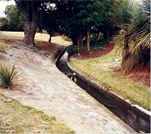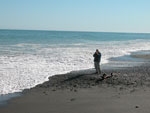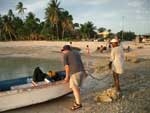PDF of this article (161 KB)



Coastal engineer Doug Ramsay casts a practised eye over the foreshore, on the lookout for potential hazards. Lured from his Scottish east coast origins by New Zealand’s friendlier climate, Doug is NIWA’s coordinator of the Natural Hazards Centre and a coastal hazard consultant, roles that find him at beaches all around New Zealand and the Pacific, assessing risks of erosion and inundation. W&A asked him about what his work entails, but first things first.
How did you become an engineer?
Growing up on a farm, I’ve always been interested in the practical side of things and wanted a career where I could spend at least some of the time outside. I was interested in science at school, and engineering was a logical step from there.
I have an undergraduate degree in Civil Engineering from Aberdeen University in Scotland. But a summer spent designing reinforced concrete beams in an engineering consultancy convinced me that I didn’t want to build things and I migrated to the watery side of engineering. After my first degree, I achieved a Masters in Water Engineering from Strathclyde University in Glasgow. As part of my thesis, I developed a model to forecast flooding from rainfall runoff for a flood-prone catchment on the south side of Glasgow, and that’s when I began to get involved in natural hazard work.
After university, I spent several years at HR Wallingford (previously the UK’s Hydraulics Research Laboratory) in Oxfordshire, England. My work there involved understanding how coasts change, how to reduce the impacts such changes have on human development at the coast, and how to inform future development to account for coastal change. One fun aspect of this work was using large-scale physical models to understand coastal erosion processes. This is where a scale model of 1–2 km of coastline is constructed in a big basin (about 50 m x 50 m in size), and erosion processes are simulated using large wave-making machines. We then used the physical model to try out different coast-defence schemes. It was just like playing in a giant sand pit and definitely more fun than doing the modelling on a computer!
And from the UK you found your way to more tropical climes?
In 1998, I moved to the Federated States of Micronesia in the Central Pacific to work for two years as Coastal Management Adviser to the Government of Kosrae, a small island of about 8000 people. There I helped the island communities develop long-term approaches to managing coastal erosion and inundation risks, as well as developing the capacity of the local staff and village education programmes. After a few more years back at HR Wallingford (and a couple of short stints in the Bahamas and Guyana), I moved to New Zealand in 2003 to work at NIWA.
What’s in your job besides the Natural Hazards Centre?
I have quite a wide-ranging role within NIWA. I coordinate quite a bit of the coastal physical process commercial work in the Hamilton office. This involves everything from identifying opportunities, to writing proposals, liaising with clients, and managing projects. My main technical role still revolves around understanding coastal hazards and the impacts these have on human development (and vice versa), both in New Zealand and in the Pacific region.
What’s the most interesting work you’ve done?
In terms of changing my perspective on the way I approached things, living on Kosrae was definitely an eye-opener. Having come from a predominantly technical background, living and working there really made me appreciate that solving coastal hazard problems was primarily about dealing with the people dimension of the issue rather than the technical issues.
Best place(s) you’ve been?
I’ve been really fortunate to have lived and worked in some pretty amazing places. Being able to live in a Pacific Island community in Kosrae was a real privilege. Likewise, more recent projects in the eight outer islands of Tuvalu and the Tokelau atolls: both are very remote places and an adventure to get to. The coastline of the Western Isles in Scotland is also a favourite place, and in New Zealand it would have to be the spectacular west coast of the South Island.
So what’s the story with the Natural Hazards Centre?
This is a joint initiative between NIWA and GNS Science. Between our two organisations, we cover most of the natural hazards that affect New Zealand, and carry out most of the related research. The Natural Hazards Centre provides a focal point for end-users and the public to access information and resources on the natural hazardscape and hazard-related risks. Our aim is to help increase the resilience of New Zealand communities and infrastructure to the effects of natural hazards. We produce a number of newsletters and publications, run short courses on different hazards, and hold a large national conference every two years; we also give presentations at a range of other meetings and conferences.
And what hazard(s) should concern Kiwis most?
This depends on where you live. In New Zealand we have a good selection of hazards to pick from, which keeps things interesting from our perspective. Obviously, a major earthquake, volcano, or tsunami would have a devastating impact but, luckily, these don’t happen very often. Possibly of more concern are those natural hazards that occur more frequently. Flooding is the most significant hazard we experience on a regular basis, and one where the magnitude and occurrence of flood events will be altered due to the effects of climate change. In the future, we’re likely to see more events like the Northland floods this past winter or the 2004 Bay of Plenty and Manawatu floods. We’re also likely to see some significant hazardmanagement issues on our coastline in the coming decades, given the ongoing level of coastal development.
Check out the Natural Hazards Centre:
